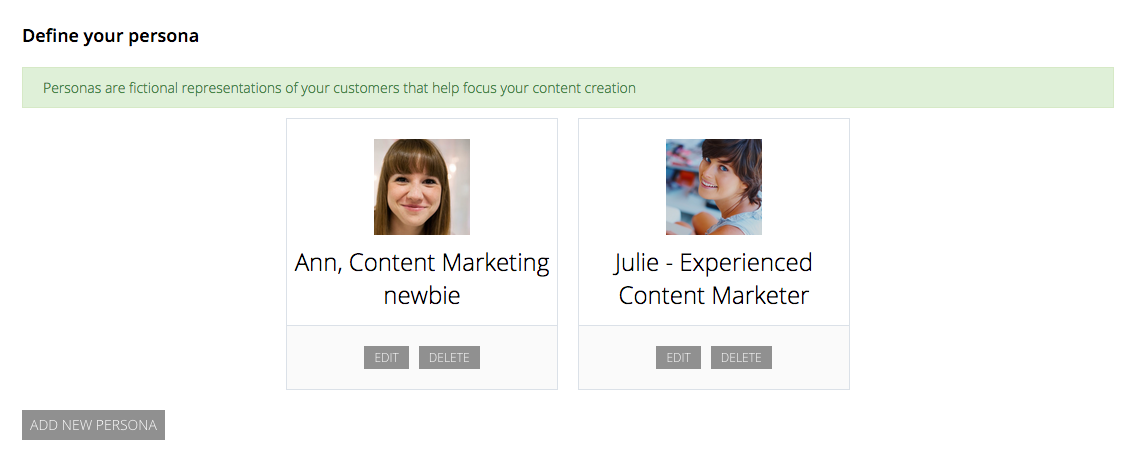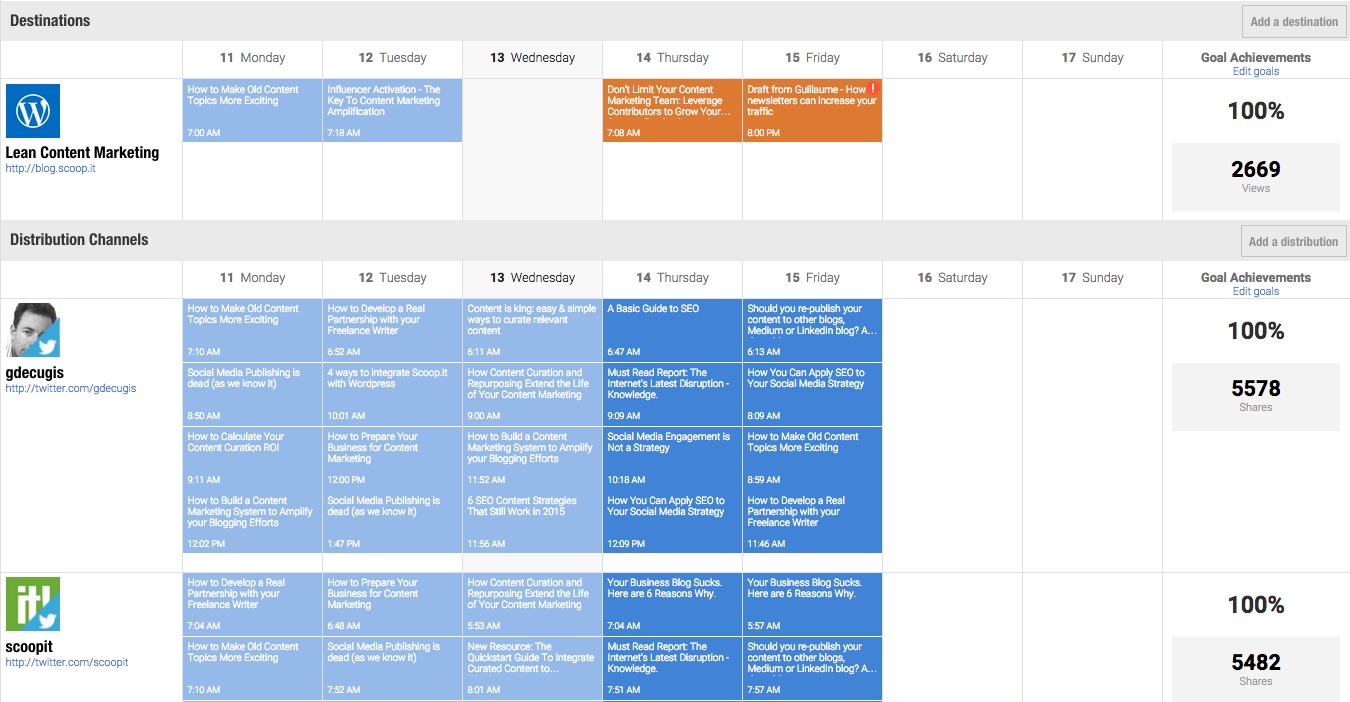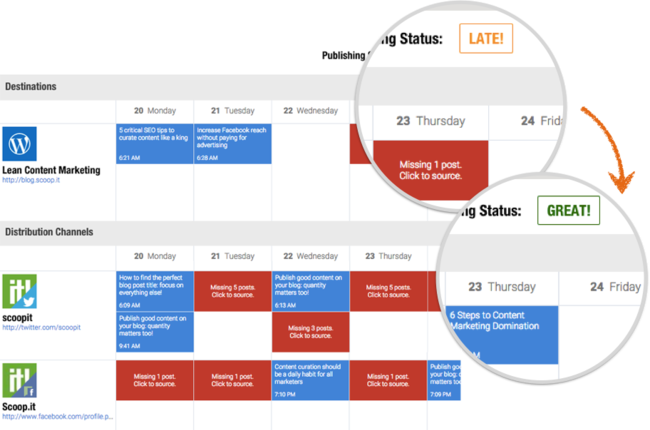
You know you need an editorial calendar. Maybe you know because you read our earlier post about it, or you know because you’re already using one… or you know because you’ve just had it with trying to manage a content marketing program with post-it notes.
Whatever the reason, you’re ready to dive in. You’ve picked the particular tool you’ll use for the editorial calendar (like Content Director) and you’re ready to start plugging your content in.
But not so fast. If you don’t put any thought into how your calendar is set up, and how you’re going to use it, then you aren’t going to get optimal results. In fact, you might still find yourself pulling your hair out trying to manage everything.
So here are a few tips on how to set up an editorial calendar that will actually help.
Here’s what you need before you start plugging content into those date boxes:
1. A documented content marketing strategy
Please don’t just start filling those calendar slots in willy-nilly. Don’t “practice random acts of content.” And don’t be among the content marketers that aren’t getting enough results from their work.
The single best way you can set yourself up for success is to have a content strategy. If you can put even enough time as it would take to write 2-3 blog posts into writing out a content strategy, your work for the entire year ahead will generate far better results.
Don’t have a content strategy? Read our ebook, How to design a content strategy that generates leads from day one.
That content strategy will immediate influence what goes on your calendar. It’s essential to help you winnow a pile of great content ideas down to the content that will actually generate business results.
There are two elements of your content strategy that should have center stage in your editorial calendar:
-
Documented and defined content personas defined.
If you’re like most companies, you have more than one type of customer. Those different types of customers are called “personas”. They need different types of content to address their specific needs. See our resource on how to develop your audience personas.
These personas appear in your editorial calendar when you actually schedule content for these different personas. Otherwise, it’s all too easy to forget personas… or to have gaps in your content for each step of each persona’s buyer’s journey.
-
Documentation of each persona’s buyer’s journey.
You don’t want all your content to be just for the top of the sales funnel. So define your different buyers journeys so that you create at least a few pieces of content for each step of those different journeys. Then map out that content development on your editorial calendar. See how to create content for every stage of the buyer’s journey.

Define your audience or customer personas before you start filling in your editorial calendar.
2. A documented content development workflow
One of the best benefits of having an editorial calendar is to smooth out your workflow. You don’t just want to use your editorial calendar for the final due date for each piece of content. You’ll use the basic stages of your workflow in the “status” field of each piece of content.
Here’s an example workflow for a blog post:
- Idea generated
- Idea approved
- Draft written
- Draft edited
- Art created
- Set up in WordPress
- Final draft approved
- Published
- Initial shares for social media
- Email announcement sent
- Influencer outreach emails sent
Each one of those steps could be a status setting for the blog post. The statuses might be different for ebooks, or videos, or podcasts or research studies. It’s up to you how you set things up… but it is critical to have some kind of workflow.
You’ll also need your calendar to be set up so the appropriate team members get reminders about the due dates for each content piece – and so that the content marketing manager gets a notification if a deadline is missed.

3. Knowledge of what’s worked in the past
I know – by now, you just want to dive in and start filling up your calendar. Enough planning! Enough homework!
But wait. Why schedule more of the types of content that work for you, and schedule less of the content that doesn’t.
Not sure about which content is even working? Read our post about how to do a quick version of a content audit.
We get that all this can feel like a pain… but really, each of these steps is worth it. Otherwise, you’ll just do a ton of work, get mediocre results, and then have to tear apart your editorial calendar all over again.
It’s easier to do things right the first time.
In addition to all the content you’ve planned, leave some space for:
1. Holidays, known vacation times and company events.
These are days you know when things aren’t going to get done. So you might as well plug them into your calendar now, rather than trying to reschedule things later.
2. Opportunities
Like when your CEO gets inspired and writes a post. Or an influencer wants to write a guest post for you. Or … who knows what?
Leave at least one empty space per month, but just make sure you manage it intelligently.
3. Time to update or reformat existing content
These are two separate tasks. You want to update your top-performing content at least once a year. And then you may want to take that top-performing content and convert it into another type of content. Reformat it, as some would say.
4. Problems
Do you work at a company where there are never any surprises? Where nothing ever goes wrong, people never get sick, or have personal emergencies, or just simply miscommunicate?
No? Us neither.
We may not be able to control these events, but we can prepare for them. It’s smart to have a couple of blog posts ready for publication… Just in case something goes wrong with your content production pipeline.
That way, you have something on hand at any time, ready to publish. Ideally, you’ll even have some emergency content in different formats, like a couple of blog posts, an infographic… maybe even a video. Even an “outtakes” video can work… or a curated blog post about a specific topic. Whatever it is, it just might save your bacon one day.

Have a system in place for when things go wrong.
A word about having multiple editorial calendars
Some marketers do use multiple editorial calendars. Some even say their multiple calendar system works for them.
Other marketers have found that multiple editorial calendars just makes for multiple headaches.
Our ideal is to have everything on one editorial calendar, but to have the ability to switch views so you can see your major channels/content formats one at a time.
This keeps all the information together, but lets you screen out distracting information if you want to focus on one particular channel – like your blog, for example. Or your social media posts.
Another reason toggling your editorial calendar works well is because it nudges you to create different types of content (like podcasts, events, ebooks, videos, etc), and makes managing those different types of content easier.
Closing thoughts
As you can see, there’s a lot going on in most editorial calendars. Even if you only publish one blog post a week, each one of those posts has multiple workflow steps, and each of those steps needs to be on the calendar.
That’s why we appreciate full-featured editorial calendars. You can absolutely manage all your content from Google Calendar, or Trello, or even via a spreadsheet. But most content marketing programs are active enough that they need a few bells and whistles.
Back to you
How is your company’s editorial calendar set up? Got any tips to share? Leave a comment and share your wisdom with us.
Want to work smarter and start generating real results from your content marketing? Find out how to use the new Scoop.it Content Director to help you become a smarter marketer!



Yeah. Creating an editorial calendar is the best thing one can do to enhance their content marketing efforts. We have been in a mess while managing the content marketing for our brand. Thanks for the cool suggestions.